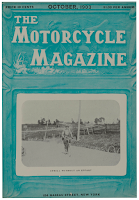 |
| The Bicycling World and Motorcycle Review, April 25, 1903 |
With the help of the California Motor Company and Goodman publishing, Wyman finalizes preparations for his epic motor-cycle ride across America. It is likely this two sentence news clipping was the first public notice of Wyman's attempt. It would be the beginning of publicity designed to launch The Goodman Company's new periodical, "The Motorcycle Magazine."
Since the California Gold Rush days, the distance between San Francisco and New York City set the standard for cross continent travel. The completion of the transcontinental railway shortened a grueling eight week wagon journey to a relatively comfortable 83 hour express train ride.
 |
| Iron Butt Magazine, Spring 2013 |
Wyman's 50 day motorized journey from San Francisco to New York City represented the next step in the technology of personal transcontinental travel. Today, on modern motorcycles, members of the Iron Butt Association pay tribute to Wyman's legacy, making the San Francisco to New York City ride in under 50 hours.
George A. Wyman...
"World's Toughest Motorcycle Rider, circa 1903"













